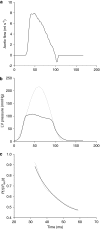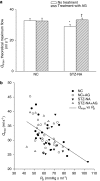Aminoguanidine prevents the impairment of cardiac pumping mechanics in rats with streptozotocin and nicotinamide-induced type 2 diabetes
- PMID: 18376420
- PMCID: PMC2439860
- DOI: 10.1038/bjp.2008.119
Aminoguanidine prevents the impairment of cardiac pumping mechanics in rats with streptozotocin and nicotinamide-induced type 2 diabetes
Abstract
Background and purpose: Aminoguanidine (AG), an inhibitor of advanced glycation endproducts, has been shown to prevent arterial stiffening and cardiac hypertrophy in streptozotocin (STZ) and nicotinamide (NA)-induced type 2 diabetes in rats. Our aims were to examine whether AG produced benefits on cardiac pumping mechanics in the STZ and NA-treated animals in terms of maximal systolic elastance (E(max)) and theoretical maximum flow (Q(max)).
Experimental approach: After induction of type 2 diabetes, rats received daily injections of AG (50 mg kg(-1), i.p.) for 8 weeks and were compared with age-matched, untreated, diabetic controls. Left ventricular (LV) pressure and ascending aortic flow signals were recorded to calculate E(max) and Q(max), using the elastance-resistance model. Physically, E(max) reflects the contractility of the myocardium as an intact heart, whereas Q(max) has an inverse relationship with the LV internal resistance.
Key results: Both type 2 diabetes and AG affected E(max) and Q(max), and there was an interaction between diabetes and AG for these two variables. The E(max) and Q(max) were reduced in rats with type 2 diabetes, but showed a significant rise after administration of AG to these diabetic rats. Moreover, the increase in Q(max) corresponded to a decrease in total peripheral resistance of the systemic circulation when the STZ and NA-induced diabetic rats were treated with AG.
Conclusions and implications: AG therapy prevented not only the contractile dysfunction of the heart, but also the augmentation in LV internal resistance in rats with STZ and NA-induced type 2 diabetes.
Figures



References
-
- Avigad G, Kniep A, Bailin G. Reaction of rabbit skeletal myosin with D-glucose 6-phosphate. Biochem Mol Biol Int. 1996;40:273–284. - PubMed
-
- Baynes JW, Thrope SR. Role of oxidative stress in diabetic complications. A new perspective on an old paradigm. Diabetes. 1999;48:1–9. - PubMed
-
- Bidasee KR, Nallani K, Yu Y, Cocklin RR, Zhang Y, Wang M, et al. Chronic diabetes increases advanced glycation end products on cardiac ryanodine receptors/calcium-release channels. Diabetes. 2003;52:1825–1836. - PubMed
-
- Bidasee KR, Zhang Y, Shao CH, Wang M, Patel kp, Dincer ÜD, et al. Diabetes increases formation of advanced glycation end products on sarco(endo)plasmic reticulum Ca2+-ATPase. Diabetes. 2004;53:463–473. - PubMed
-
- Brown MR, Knull HR. Effects of nonenzymatic glycation of subfragment-1 of myosin on interaction with actin. Biochem. Cell Biol. 1992;70:617–622. - PubMed
Publication types
MeSH terms
Substances
LinkOut - more resources
Full Text Sources
Medical

